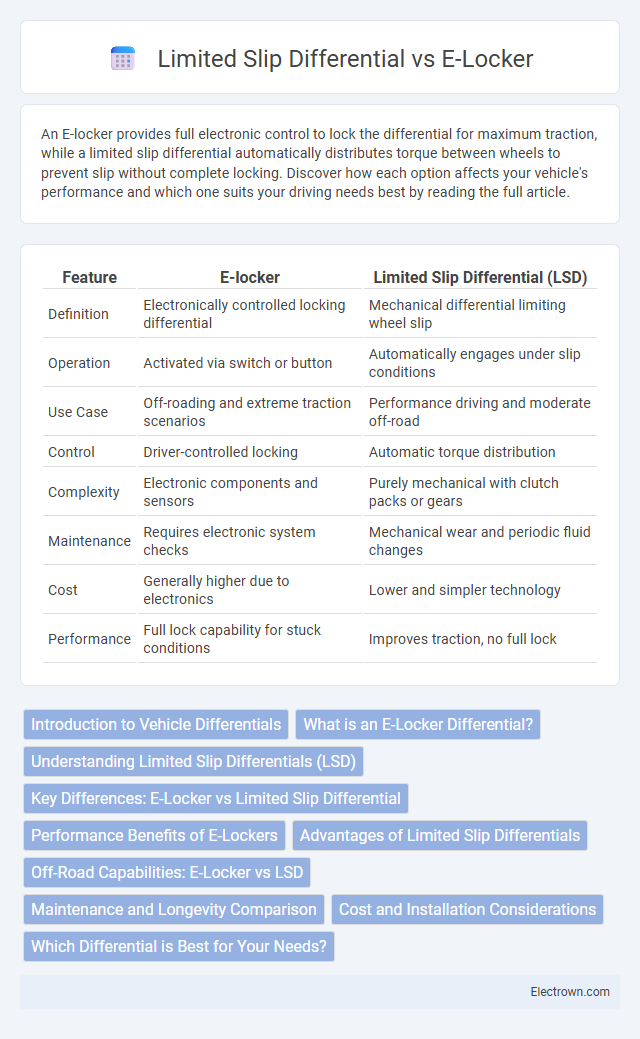An E-locker provides full electronic control to lock the differential for maximum traction, while a limited slip differential automatically distributes torque between wheels to prevent slip without complete locking. Discover how each option affects your vehicle's performance and which one suits your driving needs best by reading the full article.
Table of Comparison
| Feature | E-locker | Limited Slip Differential (LSD) |
|---|---|---|
| Definition | Electronically controlled locking differential | Mechanical differential limiting wheel slip |
| Operation | Activated via switch or button | Automatically engages under slip conditions |
| Use Case | Off-roading and extreme traction scenarios | Performance driving and moderate off-road |
| Control | Driver-controlled locking | Automatic torque distribution |
| Complexity | Electronic components and sensors | Purely mechanical with clutch packs or gears |
| Maintenance | Requires electronic system checks | Mechanical wear and periodic fluid changes |
| Cost | Generally higher due to electronics | Lower and simpler technology |
| Performance | Full lock capability for stuck conditions | Improves traction, no full lock |
Introduction to Vehicle Differentials
Vehicle differentials play a crucial role in distributing engine torque to the wheels, enabling smooth turns and maintaining traction. An E-locker electronically locks the differential to provide maximum traction by ensuring both wheels on an axle rotate at the same speed, ideal for off-road or slippery conditions. A limited slip differential automatically limits wheel spin by transferring torque to the wheel with more grip, enhancing stability and control during everyday driving situations.
What is an E-Locker Differential?
An E-Locker differential, or electronic locking differential, uses an electronically controlled mechanism to lock the differential gears, distributing equal torque to both wheels on an axle for improved traction. Unlike limited slip differentials that rely on clutch packs or viscous fluids to limit wheel slip, E-Lockers engage via an electric actuator, providing full lock or unlock capability on demand. This technology enhances off-road performance and stability by preventing wheel spin in low-traction conditions.
Understanding Limited Slip Differentials (LSD)
Understanding Limited Slip Differentials (LSD) involves recognizing their role in improving traction by distributing torque to wheels with better grip during turns or on slippery surfaces. Unlike e-lockers, which fully lock both wheels for maximum traction, LSDs provide variable torque transfer, enhancing vehicle stability and control without sacrificing maneuverability. Your vehicle's performance benefits significantly from LSDs in off-road or low-traction conditions by preventing wheel spin while maintaining smooth cornering.
Key Differences: E-Locker vs Limited Slip Differential
E-Lockers provide full wheel lock-up by mechanically engaging both wheels on an axle to rotate at the same speed, maximizing traction in extreme off-road conditions. Limited Slip Differentials (LSDs) allow for some difference in wheel speed while distributing torque to the wheel with more grip, improving handling and stability on varying surfaces. Unlike LSDs, E-Lockers offer on-demand locking that can be activated electronically, making them ideal for challenging terrains where maximum traction is essential.
Performance Benefits of E-Lockers
E-Lockers provide superior traction by electronically locking the axle, ensuring both wheels spin at the same rate and significantly improving off-road and low-traction performance. Unlike limited slip differentials, E-Lockers offer instant, full locking engagement, which maximizes your vehicle's ability to tackle difficult terrain without wheel slip. This precise control enhances stability, improves power distribution, and reduces the risk of getting stuck in challenging conditions.
Advantages of Limited Slip Differentials
Limited Slip Differentials (LSD) enhance traction by distributing torque more effectively between wheels, preventing wheel spin during acceleration or on slippery surfaces. They improve vehicle stability and handling in corners by allowing wheels to rotate at different speeds while maintaining power delivery. Unlike E-lockers, LSDs provide smoother engagement and continuous traction without the need for electronic activation.
Off-Road Capabilities: E-Locker vs LSD
E-Lockers provide superior off-road capabilities by fully locking the axle, ensuring both wheels rotate at the same speed for maximum traction on slippery or uneven terrain. Limited Slip Differentials (LSD) improve grip by transferring torque to the wheel with more traction but allow some wheel slip, making them less effective in extreme off-road situations. Your off-road adventures will benefit more from an E-Locker when navigating challenging trails requiring maximum traction and control.
Maintenance and Longevity Comparison
E-lockers generally require less frequent maintenance than limited slip differentials (LSDs) due to their simpler mechanical design and fewer moving parts, reducing the risk of wear and tear. Limited slip differentials often need periodic fluid changes and clutch pack replacements to maintain optimal performance and extend their longevity. Choosing between the two depends on the intended application, with E-lockers favored for durability in off-road conditions and LSDs requiring more upkeep but offering smoother torque transfer.
Cost and Installation Considerations
E-lockers generally have a higher upfront cost and require professional installation due to their complex electronic components and integration with vehicle systems. Limited slip differentials (LSDs) are usually more affordable and easier to install, often compatible with stock housings and requiring minimal modifications. Budget-conscious buyers should consider the total cost of parts and labor when comparing E-lockers and LSDs for their off-road or performance needs.
Which Differential is Best for Your Needs?
Choosing between an E-locker and a limited slip differential depends on your specific driving conditions and vehicle use. An E-locker provides full and instant locking capability, ideal for off-road enthusiasts needing maximum traction on challenging terrain, while a limited slip differential offers smoother, automatic torque distribution for improved handling and stability on paved roads. Your best choice hinges on whether you prioritize aggressive off-road performance or everyday drivability and safety.
E-locker vs Limited slip differential Infographic

 electrown.com
electrown.com